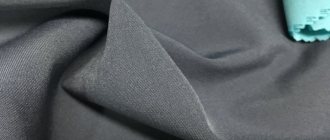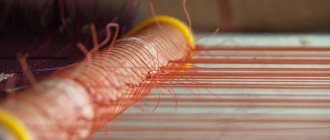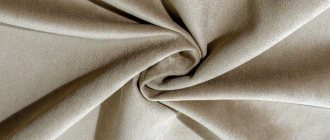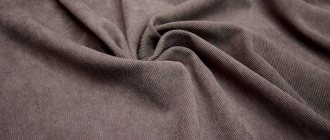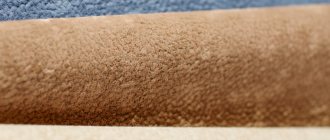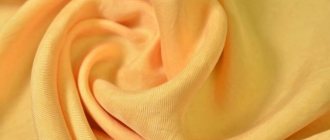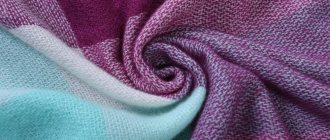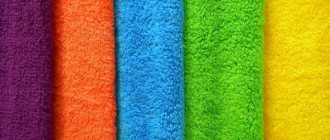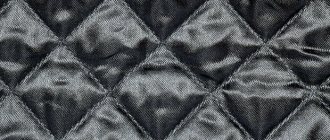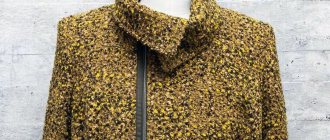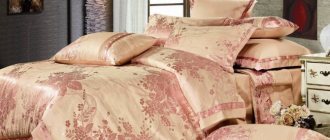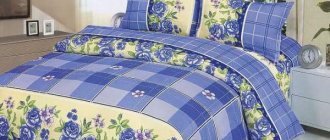Almost all modern clothing is either entirely or partially made from synthetic materials.
If previously the word “synthetics” was associated with low quality, now artificial fabrics have reached a new level.
One of the most popular materials is polyester. Absolutely every person has clothes made from this fabric in their wardrobe, and in recent years, polyester has also stepped up to a new level, emerging as a promising industry for recycling plastic waste .
Let's talk in detail about polyester and figure it out:
- what kind of fabric is this, what are its properties;
- pros and cons of the material;
- the advantages of clothing and other things made of polyester;
- how it is used as a filler and insulation;
- what is made from it, what products are made;
- how they are made from recycled materials, and whether the quality and characteristics suffer;
- is it harmful to health?
Characteristics and properties of fabric
This is a woven material consisting of synthetic fibers. It is also known by other names:
- lavsan;
- polyethylene terephthalate;
- PAT.
Every major textile company tries to patent the slightest changes, assigning more and more new trade names.
But the essence remains the same, polyester (polyethylene terephthalate) is used as a base . Only the methods of forming the fiber and weaving the threads differ.
Types of material and description
Types of threads and fibers:
- Hollow structure fiber . It has voids inside, due to which it has exceptional thermal insulation properties.
- Staple fiber . It is short in length, only about 50 mm. It is used for the production of fillers and insulation materials.
- Structured (filament) thread . Used for finishing products. The stretchability of the threads is satisfactory, they cling firmly to each other.
- Monofilament . It has practically unlimited areas of application. Depending on the density of the weave, it can be used to make the finest chiffon and dense bologna.
The modern weaving industry combines lavsan threads with fibers of natural and artificial origin. The range of fabrics based on the mixture is extremely wide. As you can see in the photo, products made from the same material can look completely different.
Naturally, the characteristics of each material are unique. But there are still some common properties that distinguish polyester fibers:
| Property | Meaning |
| Density | 1.38-1.4 g/cm3 |
| Water absorption | 0,3 % |
| Relative extension | From 10 to 60% of original length |
| Resistance to aggressive environments | Resistant to water and non-polar solvents (benzene, liquid paraffin, oils). Unresistant to acetone, chloroform, benzene, toluene |
| Melting temperature | 270 °C |
Advantages
Polyester is valued for the following qualities:
- Wear resistance . There are no creases left on polyester products. When worn, the item does not wrinkle and does not lose its original appearance for a long time.
- Bright colors . The fiber lends itself well to dyeing with all known types of dyes, which allows you to obtain almost any shade.
- Easy to care for . Machine washable, dries quickly.
- Hypoallergenic . Polyester, made from high-quality raw materials, does not cause allergic reactions.
Flaws
Synthetic polyester fabric still has some disadvantages that hinder its widespread use:
- Low moisture absorption . On the one hand, this is a plus, but on the other hand, clothes made of lavsan are very uncomfortable in the heat.
- Causes negative skin reactions . Polyester is harmless, but the fact that the skin does not breathe leads to increased sensitivity. People prone to allergies should pay attention to this.
- Not suitable for children's clothing . It is not advisable for young children to buy such things. The exception is outerwear.
WOOL
No matter how strange it may sound, woolen items are almost the main culprits of irritation and rashes on the skin. This is due to the skin's reaction to natural wool treated with dyes (with the exception of hypoallergenic merino wool and cashmere).
Despite all the advantages of natural wool, it is better to wear items made from it as a “second layer”, trying to avoid direct contact with the skin (for example, for a pullover that you wear over a bra, it is better to choose thick cotton or even polyester if you tolerate it normally, and not natural wool).
Applications: clothing, fillings and insulation
Polyester finds the following areas of use:
- Production of fabrics for bedding . It can completely replace the usual cotton, or only part of it. Adding lavsan greatly facilitates laundry care.
- Bolon and raincoat fabric for outerwear . The dense material is resistant to moisture and is not blown away by the wind.
- Material for awnings and tents . Polyester itself is not entirely suitable for technical fabrics. But in combination with impregnation and other polymers, it is simply irreplaceable in the production of travel equipment.
- All known types of fabrics, from twill to jacquard. Manufacturers have learned to replace natural materials with lavsan, while maintaining the unique texture of the fabrics.
- Fillers and insulation materials . All insulation materials that have been popular in recent years (holofiber, padding polyester, padding polyester, Thinsulate, etc.) are made of polyester.
The production of clothing and footwear from plastic waste is rapidly gaining momentum. Maybe you also have items made from recycled plastic in your wardrobe?
BAMBOO (rayon, rayon)
Bamboo fabric has many advantages - it absorbs moisture almost as well as cotton, it is lightweight, holds its shape well, and is very cheap to produce. Shirts, socks, bedding and underwear are often made from bamboo, and manufacturers claim that this material is in no way inferior to natural ones.
Unfortunately, during the manufacturing process, bamboo fabric is subjected to very harsh chemical treatment in order to turn the hard bamboo into soft yarn. A large number of allergies to this material are due to the fact that the fabric contains residues of sulfides, soda hydroxide and even sulfuric acid.
- Polyester + elastane: a great combination for beauty and comfort
Production from recycled materials
You should not think that reusing PET somehow worsens the properties of polyester, making it more toxic and of lower quality.
In European and Asian countries, exclusively recycled materials are used for sewing clothes .
Our country is just entering this stage when plastic products can be given a second life.
Of course, recycling in developed countries encourages separate waste collection. In our country, this approach is not widespread enough. But, of course, there are sources of recyclable materials in Russia.
There are companies that produce equipment for recycling polyethylene terephthalate into fiber. They take into account all the subtleties and nuances of the process, which allows them to achieve high quality products. Developers of polymer additives have long proposed good ways to restore the properties of recycled PET .
Recycled plastic fibers are resistant to sunlight and UV exposure.
The strength and manufacturability of recycled PET yarns can be enhanced by adding virgin raw materials .
In addition, there are macromolecule chain extenders, brighteners and antioxidants. The introduction of very small quantities of these additives into processed raw materials significantly improves the quality of the fiber and extends its service life.
Modern pigments and dyes for synthetic fabrics have good hiding power. Therefore, slight variations in the shade of recycled fibers will not be noticeable, especially on dark colors.
, sizing agents (surface coatings) are applied to textiles . Finishing helps protect fabrics from premature aging and wear.
You can find more information about equipment for recycling plastic bottles here.
Reviews about the material
Christina, 27 years old I don’t have a single jacket without polyester. Looks great, strengthens, no harm plus!
Maria, 31 years old, ordered a tablecloth with napkins with the addition of this substance and is very happy! They look great not only in photos, but also in real life, they are easy to wash on your hands and dry quickly.
Olga, 21 years old. Polyester dresses are very electrified and should not be ironed from the front as they may become shiny. The only benefit I see for the clothes is that they are easy to wash.
Source
Fiber technology
The process of producing fibers from recycled polyester is further complicated by the preliminary preparation of raw materials.
Since a high degree of purification from contaminants is a guarantee of a good result, this stage must be approached responsibly.
For the production of thin fiber, only the purest recycled materials , since it is quite problematic to form and draw a thin thread.
Industrial waste is ideal :
- sprues;
- ingots;
- defects in blow molding production (bottles, preforms);
- non-woven and staple fiber trimmings;
- tourniquets, thick ropes.
Container waste PET can be used, but special attention will have to be paid to cleaning it from contamination.
In addition to standard washing operations, it is necessary to use soaking in special chemical reagents, for example, solutions of caustic soda and tetrachlorethylene.
Process stages:
- Sorting . All products must be separated by color and degree of contamination. Caps, closures and labels must be removed with special care, since the slightest impurities significantly reduce the drawability of the finished thread.
- Splitting up . It is advisable to carry out grinding to a small and homogeneous fraction, filtering dust and particularly large pieces. The crusher can be equipped with a metal separator. Read more about polymer crushers here.
- Washing. If necessary, the crushed material is washed in flotation baths and high-intensity washing complexes. For particularly contaminated products, a centrifuge is suitable.
- Drying . To dry PET, storage-type dryers and a pneumatic transport system with several cyclones are used. The stuck pieces separate well and cool in the air flow.
- Extrusion . Since polyethylene terephthalate melts easily, the extruder can be short. It must be equipped with melt filtration and dosing systems, as well as a melt pump.
- Filera . The most technically complex element. The size and number of holes is determined by the type of fiber produced. For textile thread, the thickness of the holes is no more than 0.3 mm. The die is made of high-quality metal to ensure a minimum number of stagnant zones where the material will burn.
- Cooling system . Since the fibers are very thin, they can be cooled by a stream of air in a closed chamber. Next, the already cooled threads go to winding.
- Formation of tissues. Next, the finished fiber is sent to weaving and spinning machines. The type and technical equipment of textile units depends on the type of fabric. There are many types of thread weave - twill, satin, calico, etc. The equipment of the equipment is determined by the type of finished fabric.
Why is polyester harmful?
The theory describing polymers suggests that the components of many materials are quite stable and safe, since they do not react on their own.
But to say this about monomers is a big mistake. Many manufacturers focus on the fact that the polymer is safe for humans and are silent about monomers, which often remain outside the polymer chains and can react with environmental components. And since polyester is a product of petroleum refining, the reactions can result in formations that can cause harm to human health.
Why is polyester actively used today?
This is one of the most famous synthetic types of fabric. To make the material more pleasant to the touch, it is diluted with natural ingredients (very often cotton). Thus, we get:
- The fabric is pleasant to the touch.
- The material is more breathable than 100% polyester.
- The service life of the product increases significantly.
- Things dry faster and practically do not wrinkle.
Polyester is a popular component of fabrics for the production of sportswear, sewing and filling of jackets, bed linen, curtains, curtains, carpets, and even diapers. If you pay attention to the labels on the products you buy, you will be surprised how often polyester fibers are used today. And few people think about how polyester is harmful.
Features of product care
Caring for sleeping sets made of artificial material involves performing several steps:
- Before you start washing, all components of the bed linen must be turned inside out;
- all buttons, zippers and buttons must be fastened;
- white sets should be washed with a special powder separately from colored ones;
- follow the washing temperature indicated on the label;
- Only one set should be loaded into the washing machine drum to ensure a good wash and prevent overloading of household appliances;
- Do not use bleach;
- boiling is unacceptable;
- conditioner is needed to soften the fabric;
- You need to hang such fabric to dry in the open air; you cannot dry it on a hot radiator;
- there is no need to iron, however, when ironing is needed for additional disinfection, the iron should be set to “silk” mode;
- It’s convenient to store the entire set inside one pillowcase, in this case you don’t have to search for it on all the shelves of the closet.
A sleeping set made of synthetic material has a lower price compared to its counterpart made of natural fabric. It cannot, of course, be said that it is suitable for every person. However, it will be chosen by those who do not want to carry out complex bed care and want to save money on its purchase, but value coziness and comfort in the bed. This product can be used for many years.
Why is polyester harmful?
Unfortunately, the material also has negative properties:
- It is highly electrified, collecting particles of dust, wool, and debris. This problem is easily eliminated by using an antistatic agent.
- It prevents the skin from breathing. This is why in a dress made of polyester you will quickly feel uncomfortable in the summer.
- Allergies may occur with sensitive skin. In this case, in order not to refuse a suit made from the fabric you like, choose clothes with a natural lining.
Is polyester harmful to health?
Polyester is a material obtained from petroleum products.
The manufacturing process is accompanied by the release of carcinogens into the environment. But the answer to the question: “Is polyester harmful?” not so clear cut. This is the most common synthetic fabric from which underwear, outerwear, diapers, curtains, bags, and carpets are made. People meet him everywhere. Externally, the material resembles high-quality natural fabric, but is completely different in properties. And unlike wool, polyester is hypoallergenic. It is pleasant to the touch, does not wrinkle, holds its shape well, does not absorb water, and does not require special care. Its production is economical, which means the clothes are affordable.
